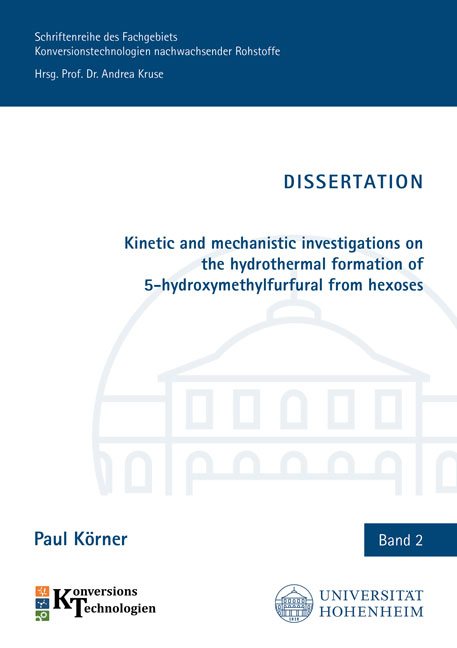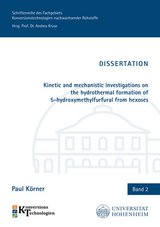Kinetic and mechanistic investigations on the hydrothermal formation of 5-hydroxymethylfurfural from hexoses
Seiten
5-Hydroxymethylfurfural (HMF) features a promising platform chemical that can be produced from renewable resources and that can be used to produce numerous subsequent materials, such as plastic and fine chemicals. This is crucial taking into consideration that fossil resources, on which the chemical industry still relies, are becoming scare and their continuous use and exploitation are increasingly problematic.
HMF can be obtained by the acid-catalysed dehydration of hexoses, which can be found in biogenic resources; often in polymerized form, such as cellulose, starch or inulin.
The aim of this dissertation was to improve the understanding of the influence of acid catalyst, rest ion and pH value on the formation and degradation of HMF. It transpires that BRØNSTED acids have a compound-specific effect on the HMF formation, apart from the donation of catalytically active protons, if used in high concentrations. Furthermore, it turned out that applying pH 3 might be the most suitable parameter for the HMF production, if the starting material is already a sugar solution. In this case, the maximum HMF yield from fructose is as high as under more acidic conditions, however HMF is more stable, only low amounts of levulinic acid are formed and possibly the yields from glucose are higher, because the isomerisation into more reactive fructose is facilitated under only moderate acidic conditions.
The outcome of this dissertation provides some helpful guides for the further elucidation of the HMF formation mechanism as well as for the development of hydrothermal HMF processes.
HMF can be obtained by the acid-catalysed dehydration of hexoses, which can be found in biogenic resources; often in polymerized form, such as cellulose, starch or inulin.
The aim of this dissertation was to improve the understanding of the influence of acid catalyst, rest ion and pH value on the formation and degradation of HMF. It transpires that BRØNSTED acids have a compound-specific effect on the HMF formation, apart from the donation of catalytically active protons, if used in high concentrations. Furthermore, it turned out that applying pH 3 might be the most suitable parameter for the HMF production, if the starting material is already a sugar solution. In this case, the maximum HMF yield from fructose is as high as under more acidic conditions, however HMF is more stable, only low amounts of levulinic acid are formed and possibly the yields from glucose are higher, because the isomerisation into more reactive fructose is facilitated under only moderate acidic conditions.
The outcome of this dissertation provides some helpful guides for the further elucidation of the HMF formation mechanism as well as for the development of hydrothermal HMF processes.
| Erscheinungsdatum | 02.07.2020 |
|---|---|
| Reihe/Serie | Schriftenreihe des Fachgebiets Konversionstechnologien nachwachsender Rohstoffe ; 2 |
| Verlagsort | Düren |
| Sprache | englisch |
| Maße | 148 x 210 mm |
| Gewicht | 258 g |
| Themenwelt | Naturwissenschaften ► Biologie ► Biochemie |
| Technik | |
| Schlagworte | Bioeconomy • biomass • conversion technologies of biobased resources • Fructose • hmf • HTC • humin • Levulinic acid • Platform chemicals • Water |
| ISBN-10 | 3-8440-7434-1 / 3844074341 |
| ISBN-13 | 978-3-8440-7434-5 / 9783844074345 |
| Zustand | Neuware |
| Haben Sie eine Frage zum Produkt? |
Mehr entdecken
aus dem Bereich
aus dem Bereich




